Getting there is all the fun
Volume 1: The early years 1948-1966
|
Volume 1: The early years
1948-1966
Volume 2: College, Army,
first jobs 1966-1977
|
Volume 3: PC Revolutionary:
Computerland, Beehive, Novell 1977-1989
Volume 4: Beginning The
Great Panic: Divorce, bankruptcy, mid-life crisis 1990-1993
|
Volume 5: Being a Sea
Cucumber 1994-1997
Volume 6: Searching for
a new life, 1997-2002 (and discovering how deep the Panic Scars are)
|
|
Volume 7: Recovering
from Panic Thinking 2003-2008
|
Volume 8: Remaking a home
in the USA 2008-2010 |
Volume 9: Searching for positive feedback 2011- |
The early years
Memories from Van Aken Boulevard
I was born on June 2nd, 1948 at St. Luke's hospital in Cleveland, Ohio. I don't remember this, but I'm assured that it's so by my parents and by my birth certificate.
I spent my toddler years in the upstairs of a duplex on Winslow Road near Van
Aken shopping center. This is the Shaker Heights area, a well-to-do suburb on
Cleveland's east side. I don't remember this either, except, perhaps as brief
flashes of running across a grass covered lawn. In later years I have driven
down this street that I lived on a couple times, but I can never spot the house
-- what vague memories I have of this first house are so distorted with time
that I cannot map them to a real house on that street.
 |
One of these homes was where I lived as a toddler. It was a duplex, and
we lived upstairs. Downstairs lived the Burtons, who remained good friends
of the family. |
 |
This is the earliest picture I have of me.
Using a photo for a Christmas
card became a tradition of the family for many years. Sometimes it was kids
and parents, but often just the kids. (I'm standing, and my brother Toby
is sitting.) |
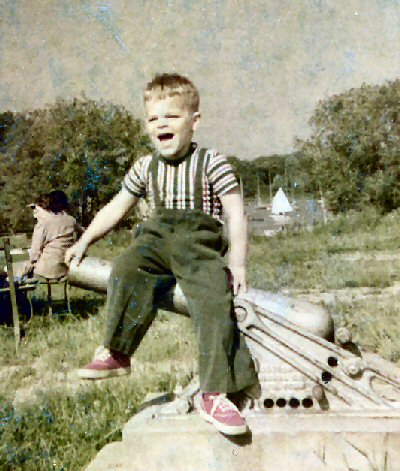 |
This is 1951, and the starting cannon at Mentor Harbor Yacht Club, where
my father kept his I-21 sailboat. As a youngster I would play on the beach
and with the big piles of dredged sand. When I got older, I would go sailing
with him. |
 |
Another 1951 shot. |
 |
The 1952 Christmas card.
We had moved into the Fairmount Boulevard house.
My first memory is of watching our furniture being moved into this house.
I remember thinking, "This is going to be very exciting."
That's our pet boxer, Harvey, between Toby and I.
|
 |
Mom, me and Toby working on something in the kitchen. (1954) |
 |
In a cowboy outfit, likely a Christmas present. Notice the plastic "glass"
in front of me. That was a brand new item at this time. |
 |
Christmas card in 1956.
(This is forty years ahead of Photoshop and digital
darkrooms, but not of photo manipulation. I remember watching my father
work with scissors and pen to make his pictures better. In this case, Harvey
was cut out of another picture, and added to this shot.) |
My mother tells me I was a wanderer. Harvey, our boxer dog, and I would follow
each other on journeys that would lead off to blocks and blocks away. I don't
recall ever feeling lost on one of these journeys. Sometimes we came back on
our own, sometimes we would be interrupted on our trek by some friendly person
giving us a ride back before we completed our trek.
 |
Thanks to the fame of my aunt, Margaret Bourke-White, there is a lot
of information published about my father's side of the family. Here
is some information on Mom's side of the family.
Margaret's pictures are widely spread around. Less common is hearing her speak about them. Here are some audio tracks of a radio interview Margaret did on the Martha Dean Show, 21 Aug 1957 talking about her work:
Part One in .wav format -- Part Two in .wav format
Part One in .mp3 format -- Part Two in .mp3 format |
Memories from Fairmount Boulevard
My earliest memory I am sure of is a flash during our move from the duplex on Winslow Road to a giant house on Fairmount Boulevard in Cleveland Heights. I remember watching my Dad backing the car with the moving trailer on it into the driveway and feeling, "This is going to be exciting." And it was. My father was building a successful high technology business, so this house was a big step up. It had three floors, a basement, a huge front yard with big trees and a huge back yard with big trees.
In this house I learned numbers. My address was 2811 Fairmount Boulevard. My
phone number was YE2-8282828282828282... At first I was never sure where to
stop, so when I dialed home I would simply dial twos and eights until I heard
the ringing start.
 |
I moved into this house at age 5. |
 |
Huge trees and verdant vegetation were a "given" of my young
life. |
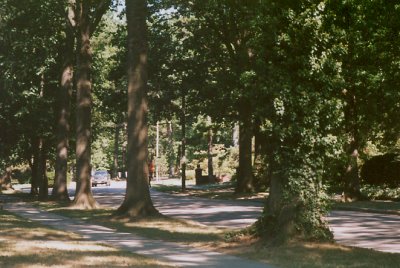 |
This was the street I learned to ride a bicycle on. |
We had a TV in this house, and this one of the first household TV's, ever --
I am a first generation TV child. My father punched a hole in the living room
wall for our first TV, and mounted the TV on a shelf in the next room. I loved
the cartoon at the end of the Mickey Mouse Club, and since my time sense wasn't
great when we first got that first TV set, I would watch a couple hours of TV
just to see that. People were complaining even back then about TV ruining young
minds, but my taste for learning geography and science was heightened by what
I saw waiting for the cartoon to come up on the Mickey Mouse Club, and soap operas
were really dull, even back then.
For kindergarten I walked to school from my house on Fairmount. It was a long
way. If I'd been on the other side of the block, I could have taken the bus...
This is my oldest memory of an arbitrary injustice. Fortunately, the walking
stopped when I started at Hawken in the first grade, it was a lot further away,
so I always took the bus.
I can remember getting to kindergarten late the second day of school, and finding
the doors closed. I walked back home, and told my mother. She said, "Just
go on in anyway." so I walked back and did so. That was a walking day!
Another time I can remember getting fascinated one warm and sunny afternoon
by water in a puddle as I was walking home from school. My fascination broke
when a cold wind started blowing and clouds and rain rolled in. I was freezing
by the time I got home; I'd been caught by one of the endless cold fronts that
roll across Ohio. I remember Cleveland weather as capricious and mostly too
cold and too windy. My early interest in weather was mostly defensive -- I wanted
to stay out of it's way as much as I could.
The big exception to that was thunderstorms. I loved the lightning flashing
and the thunder rolling. Cleveland had great thunderstorms. They would roll
and rumble long before the wind and lightning came. They would darken the afternoon
sky, or put great flashes in a night sky. Then the wind would come and sway
the trees... and lighting and lots of rain! After a good storm, branches would
be down and lawn furniture scattered every which-way. Cleveland even got tornados
once in a while, then we'd see whole trees knocked down. It was all very exciting.
Thinking about Deltas: The Nile-style "Delta" Delta and the
Mississippi-style "Bird's Foot" Delta
When I played on the beach and built sand castles, I loved to work with
running water. One of the things I noticed was the "delta building"
of sand being carried into a puddle by a stream of water from a garden
hose. I remember reading in school about deltas, and that they came in
two varieties: the "delta" like the Nile delta variety and the
"birdfoot" like the Mississippi delta variety.
As the water ran into the puddle, it was building a birdfoot delta. Sand
would deposit along the edges of the main channel, and the main channel
would extend until one of the banks got unstable and broke. The break
would then become the main channel and the extending process would begin
again.
Once I had seen and understood that birdfoot dynamic, I tried to make
my little river make a Nile-style delta. I swished out all the birds feet
and let the water flow over a nice flat base. But in spite of the nice
flat start, the delta rapidly became a bird's foot delta again. That puzzled
me, and I thought about it long after I had finished playing on the beach
that day.
Sometime later, I figured out what was missing: for a Nile-style delta
to grow: the water must flow out in a big surge -- essentially ignoring
all the banks. Then, in between surges, the flow must be so low and sediment
free that the delta building effectively ceases. So the flood stage of
the Nile River must be large and sudden, while the flood stage of the
Mississippi must be slow and gradual.
|
A lot happened in that house on Fairmount Blvd., and in the back yard. It was
a big block I lived on, and lots of houses had connecting backyards with only
hedges or low fences between them. It easy to meet lots of neighborhood friends
by just running through our backyards.
I remember playing Tarzan on an apple tree in our yard, swinging from branch
to branch. I remember missing my grip one time and falling flat on my back.
It didn't hurt much, but for five minutes or so I couldn't breathe. That was
the first time I'd had my wind knocked out, and it was scary. (The next time
was many years later while I was playing hockey at MIT, then it was less scary
because I was learning from the experience. I've written that experience up
in one or more of my essays.)
My dad built a huge tree swing in the back yard. It was huge, and he built
a wooden platform that we could use to get on the swing and swing higher. I
would practice being a parachutist by hopping on that swing, and swinging across,
then jumping off.
I remember waking up one Saturday morning and checking just how fast I could
get out of bed and dressed -- 5 minutes. Memories.... I got pulled out of school
one day. The gym instructor looked at me and said, "Yup." The "Yup"
was he was seeing spots from German Measles on my face. I was thrilled because I got to go home early that day, a teacher drove me home, special. It wasn't
until the next morning that I started to feel sick, and I wasn't so happy.
I went to Roxborough Elementary for one year, then I went to a private school,
Hawken School, thereafter. I remember one boy, Jim Moody, doing the same. We
took entrance tests the same day. I remember the tests as being kind of fun.
I remember being disappointed that I'd completely solved the maze that was part
of the test just seconds before time was called and I was drawing like crazy,
but I didn't get a chance to finish the path. Jim was an early friend of mine.
I first saw a map of JRR Tolkien's Middle Earth in his room, and he suggested
I read The Hobbit. I did, and fell in love with the series, and this was back
in the late fifties -- long before he was "discovered". I also discovered
Robert Heinlein books at this time. Starship Troopers was my first science fiction
book, and I was hooked.
My luckiest shot
From my earliest days I've enjoyed shooting. I played "Cowboys and
Indians" with my friends as a youngster, and got a BB gun (air gun)
at an early age. At summer camp I had a chance to shoot a .22 cal rifle,
my first "real" gun -- real in that it was using gunpowder as
propellant, not air.
My luckiest shot happened on a holiday outing to the farm of a friend
of the family in eastern Ohio. We got there late, but we got out some
.22's and went bird hunting on the farm. The birds we hunted were the
small and numerous sparrows and such, not game birds. Not surprisingly,
we had better luck shooting frogs than birds -- we hit a couple frogs,
but no birds. As dusk deepened, I took the last shot of the day. I saw
a bird fly into a small tree about 50 yards away across a small pond;
I aimed at where I saw the bird land in the dark foliage, and fired. A
bird flew up out of the foliage across the pond; landed right at my feet,
and died on the spot. I had blown its tail off.
A couple years later, on this same farm, I also suffered my worst firecracker
accident. It was late evening on the Fourth of July and there were about
a dozen of us -- kids and adults -- throwing fire crackers into the pond
next to the farm house. Someone near me gave a girl a Cherry Bomb to throw.
(A Cherry Bomb was one of the two biggest firecrackers you could get in
those days. It was technically illegal in Ohio, but purchasable in one
of the neighboring states, so we always had some around for the Fourth
of July.) She bobbled the throw and it nestled next to my leg. She didn't
know where it went; I was kneeling at the time and concentrating on getting
my next firecracker ready to throw, so I didn't notice it, either. What
I noticed was a huge pain when it went off! I leapt away. It was so dark
that no one, including me, could see what had happened. It wasn't until
the next day that we discovered that fire cracker had burned a deep, quarter-sized
hole in my lower leg, and deeply bruised my upper leg. I got an anti-tetanus
booster shot for that... one of many I got in my teenage years for various
scrapes and accidents I got into.
|
Memories from South Park Boulevard
When I was ten or so, we moved from our now average-looking house to me (no
longer giant) to a mansion on South Park Boulevard. It too was three stories
high with a basement. I counted twenty seven rooms in it, and there was a tennis
court out back. The two houses were only a ten minute drive apart, so my social
life didn't change much with the move. But Steve Greenberg, my best friend
at the time, lived in the house we were moving into. It took a while for it
to sink in that I was moving in because he was leaving... headed for New York
City. Steve was one of Hank Greenberg's sons, Hank was a famous pro baseball
player.
I enjoyed the South Park house. It was bigger and there was a big park across
the road with a deep gully in it. I would go walking there with our dog -- following
our faces much as I had done on Winslow and at Fairmount. Only I was much bigger
and faster, so it wasn't so much following our faces as systematic exploring
and mapping. My dogs and I knew that park well.
 |
This was the South Park house in 1966. Across the street to the left is
the park where the dogs and I would explore. Behind the house to the right
are the swimming pool and tennis court. |
 |
This was my room. That's Dancer, our boxer, on the bed. She's being posed.
She preferred sleeping on Toby's bed in the next room, because it was next
to a heater, and she loved the heat. |
 |
Dancer, Jasmine and Joss -- our cats and dogs.
Shade, the wonder dog,
was around, but didn't make it for this scene. The cats and dogs got along
very well. |
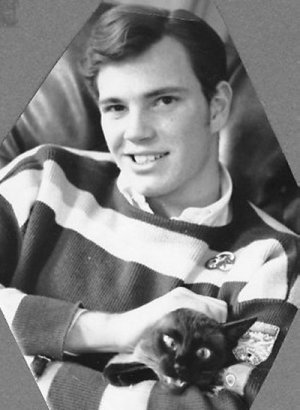 |
Toby and Joss
We loved our pets, but that didn't exclude having some fun at their expense.
One of the more memorable was figuring out how to get a cat to bounce
on a trampoline.
Getting a cat to bounce isn't easy. They are well-equipped to land quietly
and slink off.
The trick, we discovered, was to start bouncing on the trampoline, with
cat in arms. Then, as we bounced up, we would throw the cat down. The
cat would land without bouncing, and get ready to slink off. But before
it could start to slink off, we would come down. The shock of our landing
on the trampoline startled the cat, and it would "bounce" up....
usually back into our arms, and we would repeat the process!
No... the cats never did learn to enjoy this, but they didn't mind too
much, because when they had kittens, they would usually start the birthing
in my bed with me.
I also taught our ducks how to fly by throwing them in the air over the
duck pond and letting them come in for a water landing, and I taught our
dogs how to play hide-and-seek.
|
Shade "the Wonder Dog"
Which brings me to a "Shade, the Wonder Dog" story. Shade was Toby's dog; Toby is my younger brother. During my high school days Shade and Toby were both living in the house with the rest of the family, so he was de facto another family dog. Shade was a big German Shepherd, but all white -- a striking dog. He was smart and patient, too, but I didn't realize how smart and patient until this particular day....
I took Shade for a walk in the park. This was something he and I did regularly. Near my house the park is mostly wild -- there are no maintained trails or facilities, and it's about half grassy fields and half bush-filled forest. North Park and South Park roads border it, and through the center runs Tinker Creek, which has cut a gully averaging about 20-40 meters deep. The gully walls are cliffs in some places, and steep-walled in others, and I knew every path up and down them in the section near my house. This particular day as we headed into the bush, Shade and I surprised a woodchuck. The woodchuck is a rabbit-sized animal that is common in the northeast US countryside, but not common in the city, so this was quite a sight for us.
I chased it for a step or two, and it immediately turned tail and jumped into the nearest bushes. Shade was also after it, and the bushes presented no problem to him, so he jumped in as well. In five seconds, Shade and the woodchuck were both out of sight. I called for Shade, and after a minute or so, he came back out of the bushes. I told him he was a "good dog", which he was for coming back so quickly, and we continued our walk. We ranged up the gully that day for about an hour, and came out of the park about two kilometers upstream, and walked home along South Park. Shade was with me the whole time and acting quite normally. When we got home, I told Shade, "OK." which meant we were finished with our adventure for now, and he could do what he wanted.
Normally, he will go find a shady spot and lie down, but his time he didn't.
He didn't rush off, but a few minutes later I noticed he wasn't around. A few
minutes after that, I knew why: he was back, and he had the woodchuck in his
mouth! He had the patience and memory to stay with me for over an hour, then
return to the woodchuck spot on his own time, and catch it. I was impressed,
but not for the last time! This is why I called him Shade, the Wonder Dog, and
I have a few more stories about him.
Finally coping with freezing weather
Fall season was always a problem for me in high school. At Hawken we students
were expected to participate in a sport, everyone of us. Classes ended at 3:00
and we would do athletics of some sort until 5:00. I dreaded fall season because
the only two sports offered were soccer and football. I was too long and skinny
to enjoy contact sports, they were just too jarring. I was also too long and
skinny to enjoy being out doors when it was cold. I tried both football and
soccer, and ended up playing more football because I got to wear more clothes
and padding.
I remember one day being outside when it was blowing and really cold, and IT STARTED SNOWING! "Surely we go in now!" I thought, and said so. "Nope." said the coach. I had visions of frostbite the rest of that afternoon. The coach had also repeatedly forbidden us from wearing gloves, so this incident was simply the culmination of my cold-suffering; not the beginning; not the end.
I can remember coming in from playing football with hands so cold, numb and stiff I couldn't undo my uniform, and when they started warming it was worse, they ached for an hour or so. One day I discovered how to beat the ache. I would wash my hands: first in cold water, then gradually I would warm it up. I had to be careful because when my hands were that numb, their temperature sense was weak, too. It took about ten minutes, but in the end my hands would be flexible, warm and tingle instead of ache. Then I finished undressing. The extra time usually made me the last one to get on the bus home, but once I discovered the technique it was well worth it.
Winter and spring seasons weren't so bad. I could swim or ski in winter (and
wear gloves), and in spring we had access to indoor tennis to start of the season.
The Chemistry lab
Richard Fields and I both loved Chemistry. So we saved up to build a chemistry lab. I worked a paper route. It was a poor profit route because it was around my home, and the houses were far apart, but I did well at it. We set the lab up in a room in the basement of my house, and we did lots of basic experiments. We bought glassware and chemicals--real chemicals, not chemistry kit stuff. We had metallic sodium and potassium, white phosphorous, and concentrated sulfuric acid to name a few. We started doing a wide range of experiments, but I ended up doing mostly pyrotechnics and rocket fuels. One summer, I don't remember which, I worked with model rockets.
We were pretty safe. The only accident I recall was mixing powdered aluminum
and sodium peroxide for rocket fuel one time, and letting it sit over night.
I left the mixture in the mortar and pestle sitting on my desk in my room. The
next day, while I was in my room, it fizzled a bit, then it started burning.
Humidity, I suspect, interacting with the sodium peroxide. It burned hot and
fast, and there wasn't much I could do except clear stuff out of the way and
make sure it didn't spread. The pestle cracked, and the burning mass spilled
out and left a deep charcoal scar in my desk.
I did build model rockets for a couple summers. I didn't do well at it, in terms of getting them to fly high in the air, but I learned a lot about experimenting and keeping records of my experiments.
Steve Umans joined Richard and I at times, and the three of us once started
a laser building project. We didn't get far, but we did collect 20 or so old
car batteries and used them for a while as a primitive arc welder for a while.
I was impressed with the raw power 20 old batteries could generate.
 |
This is actually a scene from college, but it is a chemistry lab. I loved
chemistry, and would doodle about atoms reacting when I was trying to let
my mind relax. |
Plutonium and J. Edgar Hoover
Some time in this period, I got a chance to see half a kilogram or so of Plutonium.
The father of one of the students ran a company that used ultra high vacuum
for making things. We got to go on a plant tour. The company made ultra pure,
monocrystalline copper rods, and for some reason they had powdered Plutonium -- but
not the fissionable isotope. I got to hold the jar. I was enough of a chemistry
student at this time to know this was something pretty special.
Sometime too, in this period, the family took a vacation to Washington, DC.
I don't remember much of the vacation, but when we visited the FBI building,
my father and the family were invited to come upstairs and meet with J. Edgar
Hoover, himself. Why, I don't know, and my father professes that he doesn't
know why, either. We met with him, but I remember that I was more impressed
at that time by the .45ACP casing I was able to take home from the Tommy Gun demonstration
that preceded our visit with J. Edgar, than I was with meeting him.
My world widens
In the South Park house, my world started to grow outside the block on which I lived. I started using my bicycle and the Rapid Transit (a light rail system serving Cleveland's eastern suburbs) to go shopping. My first regular forays were for comic books. I would use my allowance to buy comic books.
Later, I learned how to use the Rapid Transit to get to Shaker Square and even to downtown Cleveland. In these days I was never much of a bus user.
My father was my first driving teacher. He was driving me to school in the
mornings. One day he let me sit between his legs and start learning to work
the controls. I started with the brake. Right at my 16th birthday I got my driver's
license. I was legal. I took my mother's Lincoln Continental convertible for
my first solo drive. It was liberation. I drove my parent's cars a lot after
that, but it was many years before I owned a car.
I took formal driving lessons, too -- what was then called "defensive
driving" courses -- and I found them very helpful. I found they laid the
foundation for the "offensive" driving style that I developed. I became a very
fast, very careful driver. I drove all around Northeast Ohio exploring and I
spent most of my attention on the trips trying to figure out where police where
hiding.
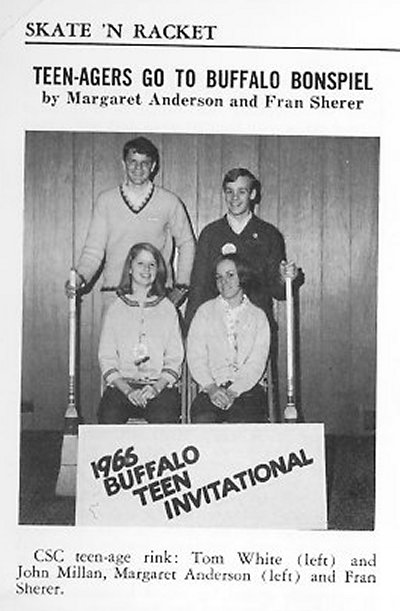 |
Curling was one of the activities I enjoyed at the Cleveland Skating Club.
I skated and played tennis here as well. |
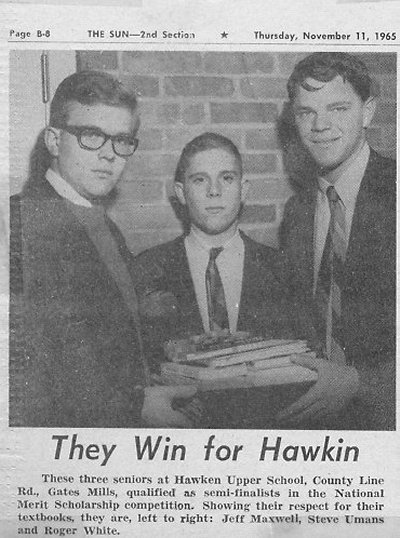 |
I always did well on tests. This was one example. |
My first wheels
My junior year in High School, 1965, I worked selling magazines during summer vacation. I turned out to be pretty good at it, and earned enough to buy a motorcycle: I paid half and my father paid half. I got a Honda Super 90, a 90cc motorcycle, the first model up from the Honda 50cc motor scooter which was just becoming popular in the US. (This was a time when motor scooters -- lead by Honda -- went through a boom in the US. Prior to it, and after it, motorcycles were more popular.)
I had mobility! I had real wheels now! My wheels! I proudly drove this to school my senior year. Even as fall turned to early winter, I was driving it, much to my dismay and my mother's. It was really cold in the morning, and riding in my school clothes offered little protection. I would spend my first class hour shivering violently as cold blood from my legs chilled my inner organs. I finally stopped and let my Dad take me to school again after I caught a bad cold.
The Honda lasted about a year, by spring it was going slower and slower. It was down to a top speed of 35mph when I traded it in for a 125cc. I bought my first car in college.
At Hawken I had three close friends: Richard Fields, Steve Umans and Don Levy. We were one of the brainy groups -- Steve and I and one other guy in our class got to the semi-finals in the National Merit Scholarship competitions. Hawken was an all-boys school while I attended. It was one of four college prep schools on Cleveland's east side: Hawken and University boys' schools and Hathaway Brown and Laurel girls' schools. I went to Hawken straight through from first or second grade. Toby bounced back and forth between Hawken and Shaker Heights High, the public school that serviced our area.
Wishing I was older
I remember just one time seriously wishing I was older. It was the South Park
days, and I was perhaps thirteen or fourteen when something abnormally vexatious
and arbitrary came up at home one evening -- I don't remember what. It involved
something that I was going to have to do for a long time, and I really didn't
want to do it... perhaps homework.
I stomped up to my room and lay on my bed sincerely wishing I could sleep through
a few years of life ala Rip Van Winkle. At first I decided I should wake up
when I was 21. I would be an adult then, and I wouldn't have to put up with
all this arbitrary shit. But, if I slept that long, I'd miss out on a lot of
driving and some good dating years. I backed down to eighteen, and finally to
sixteen. I must have been thirteen or fourteen at the time, because I recall
the time coming out to about two years, and I was surprised at how little time
that was.
Somehow, I survived those couple of years waking up each day, and things did start to get a little better when I got to sixteen.
My school experience: "There is school time, and my time, and school
doesn't get my time."
I was not a lazy student, but I did have some strong beliefs that got in the way of good grades. The first of these beliefs was how I allocated my time. For years, starting with the 4th Grade, I strenuously resisted doing homework. I didn't like school much -- the topics were mostly irrelevant -- and I sure wasn't about to have school work interfere with my home life! So I didn't take my work home with me -- once I left school, I put school work behind me for that day.
My time was always important to me. I remember first running into this problem of having "bureaucracy" control my time in day care. I can remember wanting to observe something outside -- probably a puddle since I loved water -- when a teacher came out and informed me I had to go inside and lie down for nap time. I strongly resented her having control over my time... and that was only the first instance I remember of chafing under someone controlling my time, it was far from the last. It was this infringement on my time that kept me from enjoying school until I took my MBA program in the mid-eighties.
On the other hand, I loved science, history and acquiring knowledge. So I'd
spend my home hours reading about science and history and acquiring knowledge.
from all sorts of places, including TV and movies. One summer I read the 20
volume World Book Encyclopedia cover-to-cover. I started doing the same with
the Encyclopedia Britannica, but it was a lot drier reading and I gave up on
doing a "cover-to-cover" after a volume or so. But I loved the Britannica, and
I was often in it doing leisure reading. (I hate the new versions, by the way,
that don't lay out knowledge, in alphabetical order by subject. It's so much
harder to find what I'm looking for.)
My grades in science and math were always admirable, my grades in English and languages were always abysmal. My English writing was poor because I could see no need for me to produce the written word when the spoken word served me so well. And French... when I was I ever going to use French? I was a very pragmatic learner, and if I didn't see value, I wasn't going to waste my time on a subject. A,A,D,D -- style report cards were common for me in all my schooling.
This drove my parents and teachers crazy, of course, and I did a lot of time
at summer school because they said it was necessary for me to catch up on these
things. It was more arbitrary injustice, but long before the fourth grade I'd
resigned myself to the fact that I lived in a pretty arbitrary world.
On Arbitrariness
Arbitrariness always stung me deeply. I hated it deeply, but I found there was little I could do about it. The response I learned was to spend the time doing what was required sullenly, and to wait for my time. This was what I disliked about school and homework. There was so much arbitrariness at school that it was important to me that I partition it away from "my time" -- my free time at home.
Seeking freedom, seeking "my time", is something that drove my thinking
all through childhood and clear up to my Computerland days.
- It was one reason why I joined the Army -- so that when I was finished, the
government would have no longer have the claim of military duty on my time.
- It was one reason I chose Chemical Engineering as a degree. Chemical Engineering
was a "hard science" degree that would qualify me for almost anything
that required a degree. Once I had that degree, I could do lots of things with
my time.
- It was something that made marriage a hard, hard choice. I was giving up
a lot of freedom that I enjoyed in a simple cohabitation relation, and I married
only so my children wouldn't be called bastards.
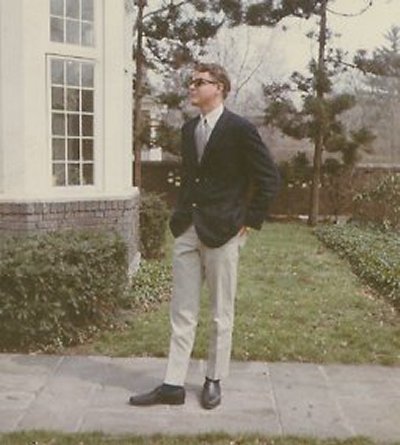 |
Getting ready for my first date, or some such.
I looked good, but I was
sure uncomfortable! (Easter 1966) |
The runner and The Program
The Runner
by Roger Bourke White Jr.
There he is again. I see him.
He's off in the distance.
A person, running. Who is he?
He looks like me, sort of.
He thinks like me, sort of.
He moves with perfect grace
He makes no mistakes
He does his homework
He plans ahead, he does what's important
The future holds no distractions
The present holds no distractions
He's the man that runs the perfect race of life.
He knows his skills and how to apply them
He knows his goals and has the consistency to keep after them
He's ahead of me. He's always ahead of me.
Every game I play, he gains a step.
Every work assignment I put off, he gains a step.
Every curious problem I take the time to solve, he gains another.
Yet he is always in sight, that perfect runner.
In my early years, he was close. I could almost touch him.
I raged when I couldn't. I screamed at each step he gained.
Now that I'm older, he has faded. He's beyond the hills.
I see him only once in a while. But to my surprise, he's still close.
He still beckons, "Come, keep stride with me. There's still time.
"You can still be dedicated. You can still be decisive.
"You can still make a difference!"
I look at him. I look at me. I chuckle.
"Go away you silly person." I say, "I'm comfortable."
But the chuckle is hollow. I still hope.
I still yearn to match the pace. I want to suffer the pain.
I want to fill the thrill.
I want the sweat of accomplishment to flow over my face.
But can my body keep up? Can I beat the habits of distraction?
Ah, the pain of uncertainty! Confusion blurs my vision of the runner.
I feel the deeper yearning to do something else -- something, anything... not decisive!
I want him to go away.
I don't like the pain of seeing what I might have been.
"Go away. I killed you long ago. I've killed you many times.
"I don't want to see you."
I get out a game, any game. It becomes important that I start playing.
With a sigh he turns away and runs off at his perfect pace.
Soon he is over the hill again; I peek up to be sure he's gone.
I concentrate hard on the game. The runner is dead again.
|
Freedom was important, but I knew I was giving up much for freedom. Not doing
my homework distressed me a lot. In my teens and twenties, I had a phantom companion
on life's journey, he was The Perfect Roger. He did his homework and didn't
waste time reading comic books. He was on his way to being the president of
the US, or a great businessman or a great scientist... whatever I wanted to
be in my daydreams of the moment. Whenever my unpreparedness in class or athletics
got me down, I'd see Perfect Roger running down life's path, always ahead of
me, always getting important things done.
God he was good! And God it would frustrate me that I couldn't keep up! He
got good grades all through school. He got into MIT the first time. He could
do "P-Chem." All this because he could do the obviously right thing at the right
time, where as I, in my pursuit of "my time", could not. (P-Chem is
Physical Chemistry: a highly mathematical version of chemistry dealing with
entropy, free energy and partition equations. To this day the goals and methods
of P-Chem mystify me.)
After I graduated from MIT, the runner, Perfect Roger, was so far ahead that I hardly ever saw him anymore.
About the same time my "program" ran out. Program as in, "get with the program." As I was growing up my folks and community helped me plan my destiny. I knew I would go to college and get a good job. In 1975 -- about five years after Perfect Roger did -- I finished college at MIT and got the good job working as an engineer at Parker Seal.
I did it! I was five years late, but I had done what the program called for.
The problem was: what to do next? My program since childhood ran out at that
point. I remember feeling the gap about three months after starting at Parker.
I wrote to Bob Cornell -- a family friend who had helped me get into Parker
-- to report my progress and to help me get a feel for what would come next.
I was proud of my work at Parker, I figured I'd done A+ work. I'd worked hard, taken some initiative, and solved a long-standing problem in O-ring production. I'd solved the "blowby problem". Bob was kind enough to write back, but he wrote back that while I was doing a good job, it sounded like B work to him, not A+.
I remember crying when I read that. It meant that my program had run out, and finding a replacement program would be no "snap task."
In fact, making a program is something that I haven't done well at, and the
older I've gotten, the poorer I've gotten at it. I no longer see Perfect Roger
because I'm so lost in the wilderness of day-to-day living that I can't find
him.
Vacations and summer camp
School was a constant in my life. It was as constant as the sun rising and the cold north wind that blew off Lake Erie. Vacations, on the other hand were always different.
Summer camp was another constant, and I thought of it basically as an extension
of school, although there was more variation in summer camp. While at summer
camp I learned wood lore, swimming, horseback riding, archery, riflery, sailing
and much more.
My father liked active vacations and didn't mind the cold, or primitive conditions.
My mother liked quieter vacations, and liked them warm and social. The result
was compromise, so we kids experienced vacations taking us as far north as Canada,
as far west as Hawaii and as far south as the Bahamas. It was great.
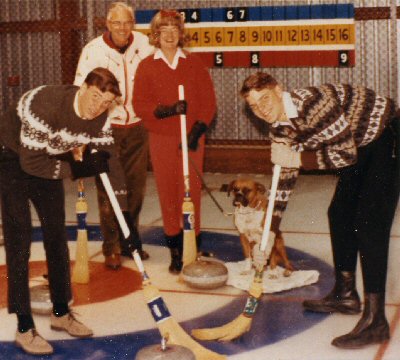 |
Another Christmas picture in the making.
This time about the sport of
curling. (1964) |
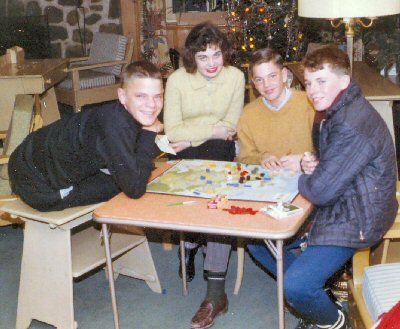 |
As early as teenagehood, I loved playing board games... all kinds of
board and card games. Here I'm playing a rare one called Diplomacy. (1963)
About two years later, I started inventing my own board games. Two of
my most popular (but unpublished) were Diplomacy Hill and Madrid. Diplomacy
Hill was this same Diplomacy game, but played with Avalon Hill-style pieces,
and Madrid put the Diplomacy Hill concept into the 1936 Spanish Civil
War setting.
|
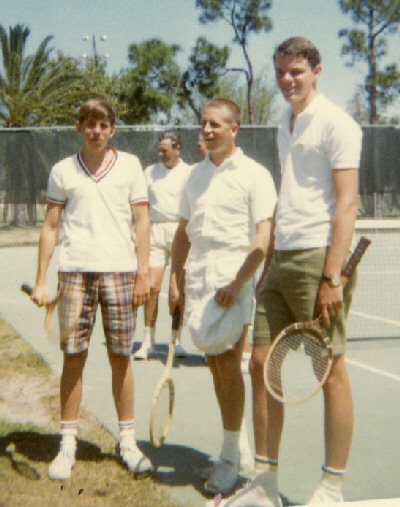 |
Tennis was a big part of my summer life. (1965) |
 |
As was swimming.
Here Toby and I are learning to scuba dive, but I enjoyed
snorkeling just as much. I loved swimming underwater. I got to where I could
swim more than the length of an olympic pool underwater, but never two.
(1965) |
 |
In 1965 I started using my father's camera to shoot pictures. This is
one of my first, of a banana flower.
I can recognize my work in his albums because I would choose different
subjects to shoot than he would.
|
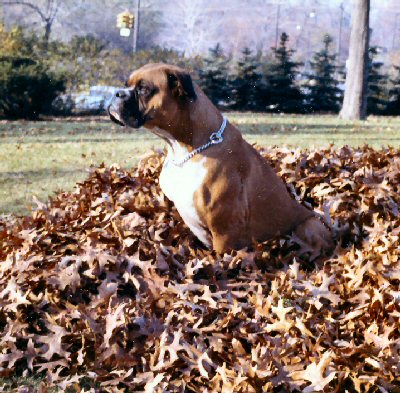 |
Another of my shots. This is Bunny. (1964) |
 |
Jasmine and Joss, our first Siamese cats.
Jasmine was female, and we soon had...
|
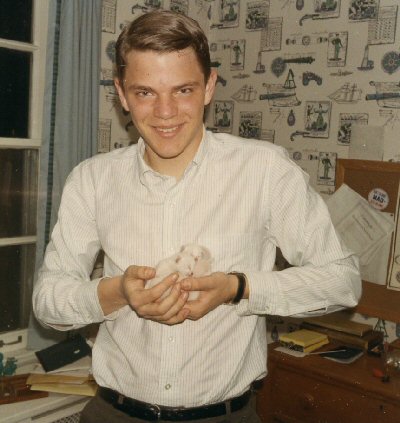 |
Kittens!
We had several litters as I grew up.
The cats would often give
birth in bed with me. I always felt honored when it happened. One time,
one of the cats waited until I got home from a trip before she gave birth.
How she arranged that, I don't know. |
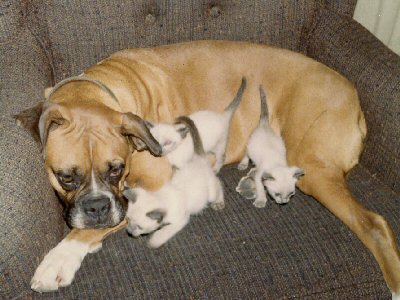 |
We always taught our cats and dogs to peacefully coexist, and Harvey was
a particularly patient dog. |
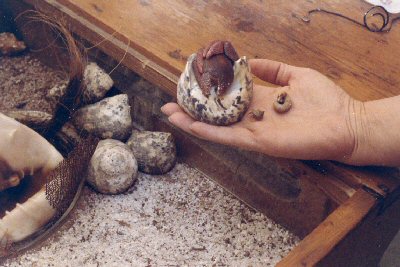 |
We also had hermit crabs as pets.
It took a lot of researching and experimenting
to get these crabs to survive more than a few weeks once we took them
off the beach. Dad was diligent, and these that you are looking at would
survive one, two, sometimes three years.
This was a unique collection at the time -- very few people were trying
to raise hermit crabs in homes in the 1960's. Years later, we started
to read about other people who were doing it, too.
|
| |
|
Family vacations
The most elaborate family vacations were to go skiing on the Christmas vacation,
and to go snorkeling on the spring break vacation in March, but there were many
variations on this theme.
I was a modestly good skier as a youngster, but, being tall and skinny, I had
a lot of limb to push around with only modest muscle, so I was never great,
and trying daring things always ended me up in a spill.
Snorkeling I found fascinating. I was a decent swimmer, I had a lot of wind
and I loved the bright colors and animation of coral reefs. I also loved moving
water and sandy beaches. I would spend hours building sand castles that consisted
mostly of canals moving water from place to place.
We also visited places such as New York City, where my "Aunt Peggy" lived.
(Margaret Bourke-White) and Chicago where my Aunt Ruth lived. (Ruth White) In
the cities we would visit museums, catch plays and eat at ethnic restaurants.
We visited California a couple times, but I remember no details, and once to
Switzerland to ski.
Family vacations got us kids to many, many places. I always looked forward
to them.
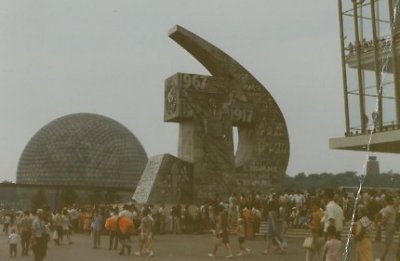 |
Visiting the world exposition (Expo 67) in New York City.
This was a
fascinating place. Exhibits from dozens of countries around the world,
and exhibits from dozens of companies and other groups.
Ironically, the
best science exhibit was put on by a group promoting religion. But that
didn't bother me, I learned a lot about both at that exhibit.
This is where I saw my first huge Tesla Coil, and saw a man stand on
top of it and shoot sparks from his fingers! |
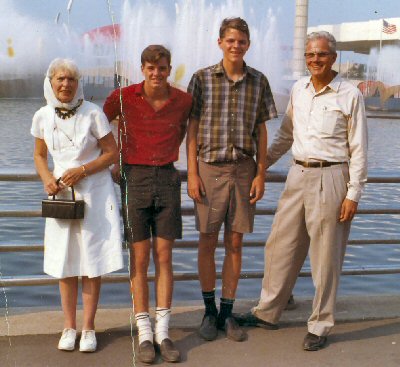 |
Aunt Peggy was with us for part of our visit to the Expo. |
 |
A drawing from 1957 (nine years old) of what I saw in the Bahamas.
From left to right we have:
- a sea anemone hiding under a rock
- a fish watching the anemone
- seaweed
- a sea cucumber next to a sea urchin, a crab and a hermit crab
- a school of fish
- and finally a snorkeler just coming on the scene and shooting a spear
at a fish.
My father and Aunt Peggy were so impressed with this that it hung for
many years on the wall in Aunt Peggy's study. |
The Sea Cucumber Story
The Sea Cucumber is in the drawing above because I had a fascinating
incident with one. The family was on vacation in the Bahamas, and my father
and I were walking across a sandy tidal flat when I spotted one lying
on the sand. It was quite alive, but it had been left behind by the tide.
With my father's assurance that it wasn't going to hurt me, I picked it
up. It was about the size of, and felt like, a vegetable cucumber. I decided
to take it home to show to the rest of the family.
As we continued our walk along the tidal flat, the sea cucumber would
occasionally squirt out sea water. Now this was getting more fun, I had
a sea cucumber squirt gun! But after one or two squirts, I noticed it
was no longer rigid like a vegetable cucumber, it was getting a little...
soft.
A few minutes later and the sea cucumber was decidedly saggy, and the
squirts were more like dribbles. It was changing! It was becoming a floppy
bag sea cucumber.
Finally it did one last squirt, but instead of squirting seawater, is
squirted out out all its guts! Eeew! Now all I had in my hand was a floppy
bag filled with nothing!
I looked at my father.
"It's a defensive maneuver." he said, "It spews it's guts
so a predator will no longer find it interesting to eat. But it's still
alive. If you were to throw it back in the water now, it would go hide,
and grow new guts."
I looked at the floppy bag in my hand, and felt sorry for the sea cucumber.
I found it hard to believe that the sea cucumber could do what my father
said, but I was willing to give it a chance. We headed for the nearest
tidal pool, and I threw it back in.
|
 |
Vacationing on Long Island, in the Bahamas. My father loved skiing and
my mother loved swimming, so we got lots of variety on our winter vacations. |
 |
One of my few fishing expeditions. This was deep sea fishing. I caught
two barracuda. |
 |
On that same trip Toby caught this huge Rock Fish.
It took 30 minutes,
and all four of us on the boat taking turns to reel it in. |
 |
Mom and Dad on Long Island, Bahamas. |
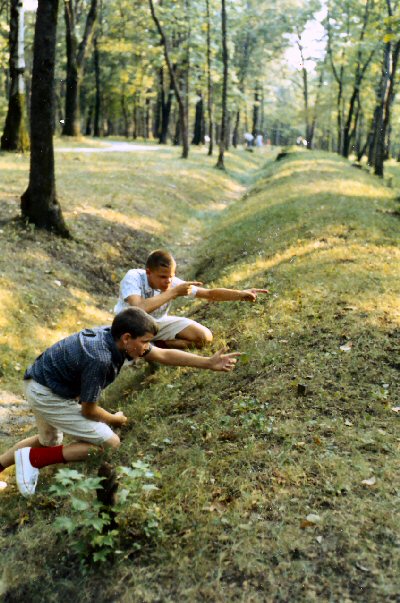 |
Visiting Gettysburg National Park. (1961) |
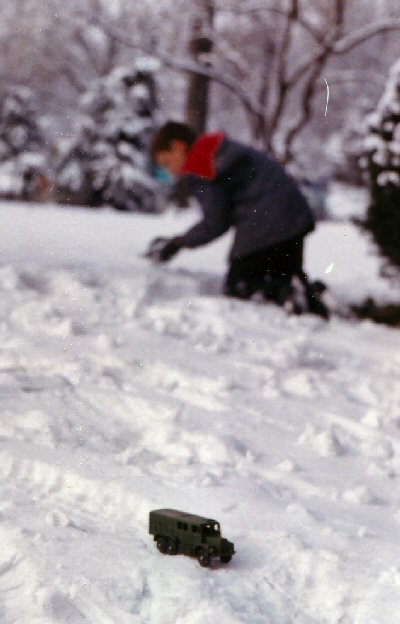 |
Christmas fun in '61. I loved board games and I loved miniatures. Here
I'm giving some of my new Christmas toys a workout in the snow. |
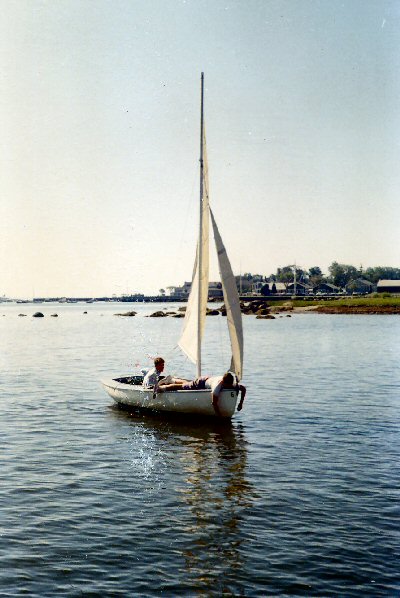 |
Sailing was a part of my life, but not as much as it was my father's.
Here I'm attending summer sailing camp, Taber Academy, in Massachusetts.
(1964) |
Europe and Outward Bound
When I graduated from Hawken my wandering of the world started in earnest.
After I left for college I came back to Cleveland for vacations and breaks,
but it was no longer a place for me to plant my feet and grow roots. It was
home for my heart, but no longer my ass.
I left without misgiving, I left with anticipation. My K-12 school years had
been a years-long siege. I had a couple close friends, but I had no vested interest
in the Cleveland community. I had not tried to relate closely to any adults
outside of my parents. My years at Hawken I'd served sullenly, because I had
to... because I could never see another way around the arbitrariness... but
not because I'd enjoyed the experience. I didn't feel I was a part of any community
when I left Hawken, and as an eighteen-year-old, that was no loss. I was close
to being free to find my own place. I couldn't wait to see what else was out
there in the world, and to get some more of "my time."
My first trip that summer after graduating was a tour of Europe. It was 35 days of hell. Richard Fields picked the beginning of the trip to cast me off as a best friend. It was a shock, and it left me with no confident to help me deal with strange places and strange food for 35 days. The trip was, however, my first foray into photography, and I did well. I borrowed Dad's Retina camera, learned how to use it before I went, and took some good pictures.
I saw England, France, Germany, Italy, Switzerland, Spain and Portugal, and
I remember little of it now... except that on this trip was the one and only
place I used the five courses of French I struggled not to learn. On the Montmartre, I asked a French artist to give me a discount because I was a student.
I stumbled through my French to ask, and he did give me a discount. But by the
end of that episode, I was more convinced that ever that I was right: the French
I'd learned was five wasted courses.
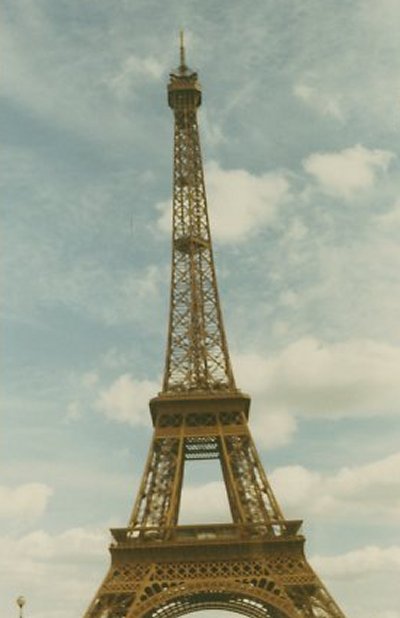 |
Europe Trip: 1966This was my first trip to Europe. It was with Hawken students, and it
was planned as a "little bit of everything" trip.
We took 35 days to travel through England, France, Germany, Switzerland,
Italy, Spain and Portugal.
It was a good trip. We saw a lot. But, it was
my first time, so I don't remember too much. |
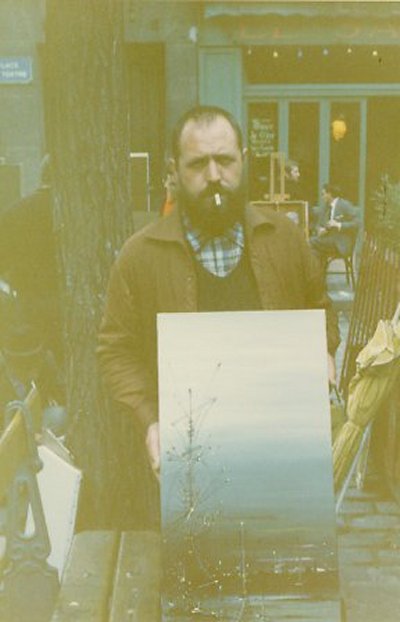 |
My first and last real world use of French.
We went went to the Montmartre and toured the artist colony there.
Five courses of French and I could ask this man.... now I can't even
remember the French! But I asked him for a discount on the price of his
painting because I was a student, and he gave me one.
That was it: Five courses of my school life... for that. <sigh>
I knew it was a waste of time from day one.
|
 |
An ornately painted building, probably in Austria, maybe Switzerland. |
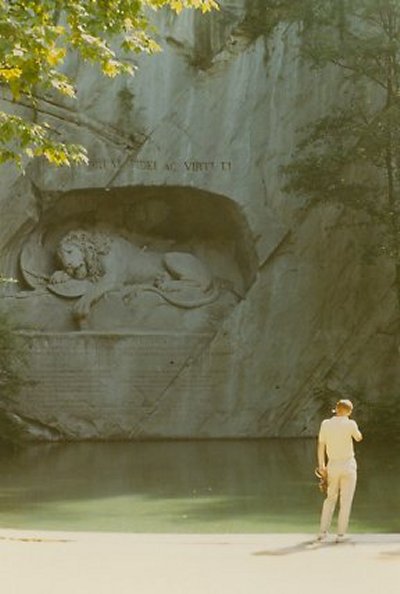 |
The headwaters of the Rhine river. The lion was neat! |
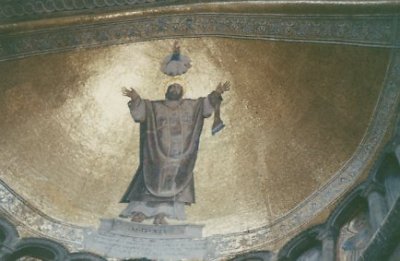 |
A church ceiling |
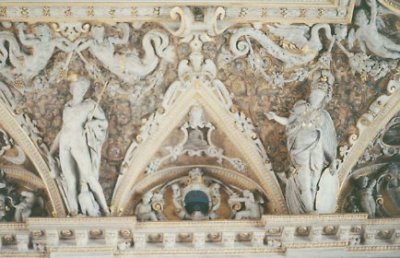 |
The bas-relief on the front of a building. |
The second trip that summer was to Outward Bound School in Colorado--a wilderness
survival school. I remember a bit more of that, and once again I took a lot
of pictures, some of which came out very well. It was another thirty days of
hell, but I didn't feel so bad about it because that was what I was expecting.
I remember being disappointed, though, when I got back. I figured that after
30 days of body-steeling adventure, I should be in great shape, so I tried running
around the block. I came back panting like a dog, it was still a tough thing
to do!
When the summer came to a close, I packed my stuff and headed off to the University
of Rochester in Rochester, New York. One chapter in my life had closed, and
another was about to open....
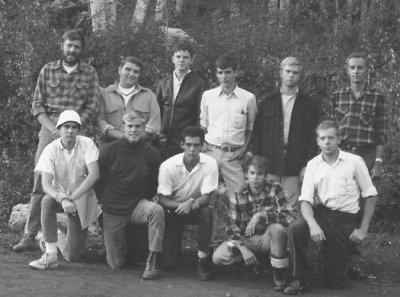 |
Outward BoundThis was my "troop" at Outward Bound. We spent 30 days together
surviving in the Colorado Rockies. I was dead center in the group in ability. |
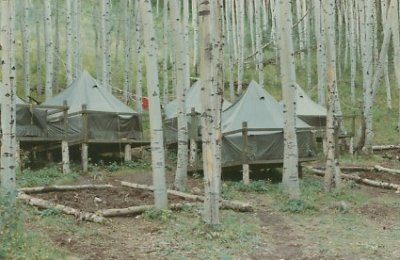 |
When we were in camp, this is where we lived. The trees around us are
old aspen, ready to die. As a result, we could practice chopping these down
in axes on the far side of the grove. That was lots of fun. |
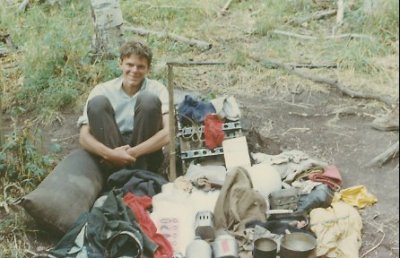 |
This is me, and what I carried when we went off hiking away from camp.
We made about three forays in our 30 days. |
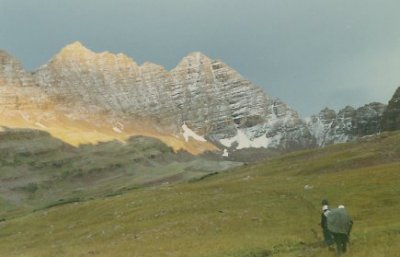 |
For the final three-day expedition the group split in two. The top group
took a "AAA" trail in difficulty. I was with the bottom group
and we took an "A" trail in difficulty. I was disappointed not
to be with the top group, but, ironically, we completed our trail, and
the top group broke off only a day out -- thwarted by diarrhea.
Here we are approaching the Maroon Belles at sunset. The Belles are shale
mountains -- very striking and very treacherous. At night water would
freeze in the shale's cracks, and by day rocks would come tumbling down
as the shale thawed out.
We had to climb through a pass at the side of the Belles. We camped close
to them that sunset, and started through the pass as close to dawn as
we could manage. |
 |
Looking down from the pass on the side of the Maroon Bells. We heard,
and saw, a lot of rocks fall, but our planning was good: they didn't fall
in our part of the pass until after we got to the bottom. |
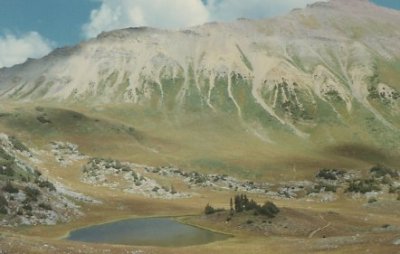 |
Another scene further on in our journey. |
|
Volume 1: The early years
1948-1966
Volume 2: College, Army,
first jobs 1966-1977
|
Volume 3: PC Revolutionary:
Computerland, Beehive, Novell 1977-1989
Volume 4: Beginning The
Great Panic: Divorce, bankruptcy, mid-life crisis 1990-1993
|
Volume 5: Being a Sea
Cucumber 1994-1997
Volume 6: Searching for
a new life, 1997-2002 (and discovering how deep the Panic Scars are)
|
|
Volume 7: Recovering
from Panic Thinking 2003-2008
|
Volume 8: Remaking a home
in the USA 2008-2010 |
Volume 9: Searching for positive feedback 2011- |



















































